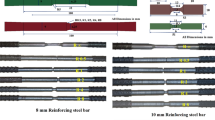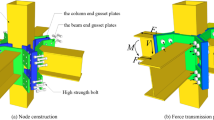Abstract
The multi-span steel tube and coupler scaffold is one of the main temporary structural forms in building and bridge construction. Given the insufficient research on their bearing capacity and design method, steel tube and coupler scaffolds have frequently collapsed in recent years and have caused serious casualties and economic losses. Through six prototype tests and a numerical analysis, this study investigated the effect of stability strengthening measures, such as vertical X-bracing, horizontal X-bracing, surrounding non-loading area, and lateral wall-tied constraints, on the ultimate bearing capacity and failure mode of multi-span steel tube and coupler scaffolds under a uniformly distributed line load of upper horizontal tubes. Using the finite element numerical analysis verified by the test data, the influence of height-width ratio, structure height, story height, spacing of vertical tubes, X-bracing layout, lateral wall-tied constraints, and surrounding non-loading area on the ultimate bearing capacity of multi-span steel tube and coupler scaffolds was analyzed. Design methods for multi-span steel tube and coupler scaffolds under a uniformly distributed line load of upper horizontal tubes were proposed based on the results of the prototype test and finite element numerical analysis. The reasonability of the design method was verified by the test data and finite element analysis results.
Similar content being viewed by others
References
Beale R.G., Godley M.H.R. (2006). “Numerical modeling of tube and fitting access scaffold systems.” Advanced Steel Construction, 2(3), pp. 199–223.
Beale R.G (2014). Scaffold research-a review. J Construct Steel Res, 98, pp. 188–200.
Chan S. L., Zhou Z. H., Chen W. F., Peng J. L., Pan A. D. (1995). “Stability Analysis of Semi-rigid Steel Scaffolding”. Eng Struct, 17(8), pp. 568–574.
Godley M. H. R, Beale R.G (1997). “Sway stiffness of scaffold structures.” The Structural Engineer, 75(1), pp. 4–12.
Liu H.B, zhao Q. H, Wang X. D, et al. (2010). “Experimental and analytical studies on the stability of structural steel tube and coupler scaffolds without Xbracing.” Eng Struct, 32(4), pp. 1003–1015.
Liu H. B, Chen Z. H, Wang X. D, et al. (2010). “Theoretical analysis and experimental research on stability behavior of structural steel tube and coupler falsework with xbracing.” Advanced Steel Construction, 6(4), pp. 946–962.
Liu H. B, Jia L. Wen S. L, et al. (2016b). “Experimental and theoretical studies on the stability of steel tube-coupler scaffolds with different connection joints”. Eng Struct, 106, pp. 80–95.
Peng J. L., Pan A. D., Rosowsky D. V., Chen W. F., Yen T., Chan S. L. (1996). “High clearance scaffold systems during construction-1: structural modeling and modes of failure.” Eng Struct, 18(3), pp. 247–257.
Peng J. L., Pan A. D., Rosowsky D. V., Chen W. F., Yen T., Chan S. L. (1996). “High clearance scaffold systems during construction-2: structural analysis and development of design guidelines”. Eng Struct, 18(3), pp. 258–267.
Peng, J. L., Pan, A. D., Chen, W. F., Yen, T., and Chan, S. L (1997). “Structural modeling and analysis of modular falsework systems.” ASCE J Struct Engng, 123(9), pp. 1245–1251.
Peng J. L., Pan A.D., Chan S. L. (1998). “Simplified Models for Analysis and Design of Modular Falsework.” J Construct Steel Res, 48(2-3), pp. 189–209.
Peng, J. L., Pan, A. D., and Chen, W. F. (2001). “Approximate analysis method for modular tubular falsework.” ASCE J Struct Engng, 127(3), pp. 256–263.
Peng, J. L, Wu C. W, Chan S. L, et al. (2013). “Experimental and numerical studies of practical system scaffolds.” J Construct Steel Res, 91, pp. 64–75.
Pienko M., Blazik-Borowa E. (2013). “Numerical analysis of load-bearing capacity of modular scaffolding nodes.” Eng Struct, 48, pp. 1–9.
Weesner L. B., Jones H. L. (2001). “Experimental and Analytical Capacity of Frame Scaffolding.” Eng Struct, 23(6), pp. 592–599.
Yu W. K., Chung K. F., Chan S. L (2004). “Structural instability of multi-storey door-type modular steel scaffolds”. Eng Struct, 26(7), pp. 867–861.
Yue F., Yuan Y., Li G. Q., Ye K. M., Chen Z. M., Wang Z. P. (2005). “Wind load on integral-lift scaffolds for tall building”. ASCE J Struct Engng, 131(5), pp. 816–24.
Zhang H, Chandrangsu T, Rasmussen KJR (2010). “Probabilistic study of the strength of steel scaffold systems.” Struct Saf, 32(6), pp. 393–401.
Zhang, H., Rasmussen K J.R., Ellingwood, Bruce R. (2012). “Reliability assessment of steel scaffold shoring structures for concrete formwork.” Eng Struct, 36, pp. 81–89
Zhang, H., Rasmussen KJ.R. (2013). “System-based design for steel scaffold structures using advanced analysis.” J Construct Steel Res, 89, pp. 1–8.
Author information
Authors and Affiliations
Corresponding author
Rights and permissions
About this article
Cite this article
Liu, H., Meng, Y., Jia, L. et al. Structural Behavior of Steel Tube and Coupler Scaffolds with Stability Strengthening Details. Int J Steel Struct 18, 79–95 (2018). https://doi.org/10.1007/s13296-018-0307-4
Received:
Accepted:
Published:
Issue Date:
DOI: https://doi.org/10.1007/s13296-018-0307-4




